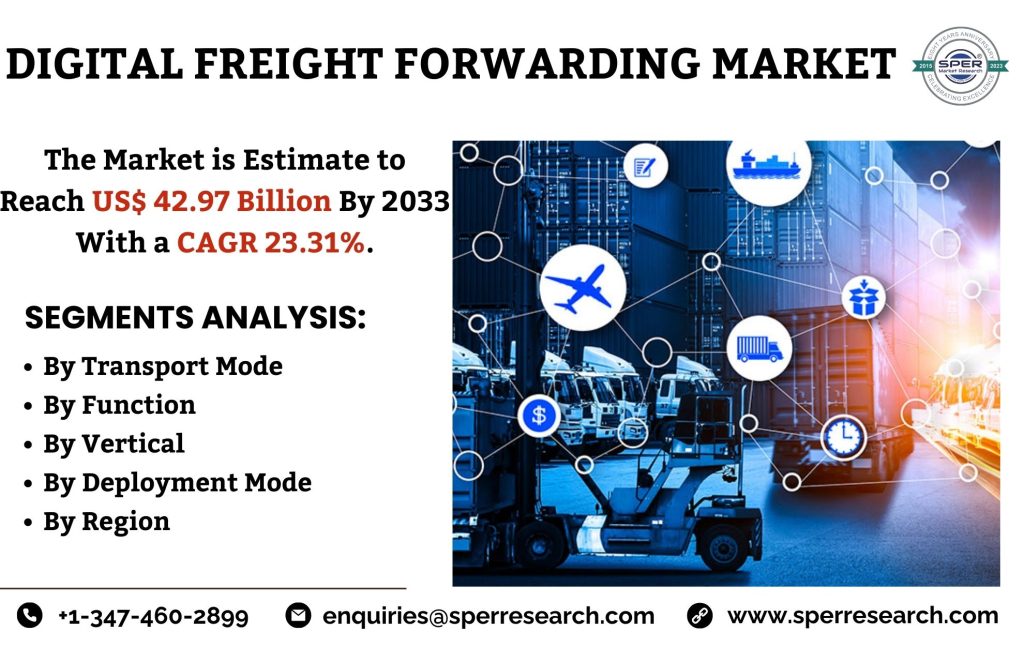Digital Freight Forwarding Market Growth, Global Industry Share, Upcoming Trends, Revenue, Business Challenges, Opportunities and Forecast Analysis till 2033: SPER Market Research

Digital freight forwarders temporarily facilitate the relationship between a carrier and a shipper by connecting shippers and carriers at any time through their proprietary platform. Utilizing digital technologies to plan and manage product shipping is known as digital freight forwarding. In order to improve customer service, businesses are implementing digital logistics solutions for their regular supply chain and logistical needs. Thus, the market’s future is greatly influenced by rising customer expectations as well as efforts to reduce logistics costs. Furthermore, the market for digital freight forwarding is expanding quickly due to the growing need for affordable supply chain and logistics solutions across a range of industrial verticals.
According to SPER market research, ‘Digital Freight Forwarding Market Size- By Vertical, By Mode of Transport, By Function, By Deployment Mode- Regional Outlook, Competitive Strategies and Segment Forecast to 2033’state that the Digital Freight Forwarding Market is predicted to reach USD 42.97 billion by 2033 with a CAGR of 23.31%.
In addition, it is anticipated that the expansion of e-commerce startups and the rise in cross-border e-commerce operations will propel the digital freight forwarding sector. A number of factors, including the significant shift toward digital transformation, the use of cloud computing and other technical advancements by small and medium-sized enterprises, and the ongoing modernization of labor management strategies in emerging economies, significantly contribute to the growth of the market. This includes shipments of electronics, prescription drugs, and consumer packaged products in addition to direct-to-consumer retail sales. As internet accessibility increases, even goods manufacturers are gradually moving from traditional freight forwarding to digital freight forwarding. Digital freight forwarding offers several advantages, such as quick quotes, clear pricing, comparing rates and carriers, tracking, simple documentation, and more.
The difficulties and inefficiencies faced by logistics organizations are caused by a number of causes. These include inefficiencies in the transportation management systems, insufficient infrastructure for storage, intricate tax laws, a slow uptake of technology in the logistics industry, and a lack of expertise among logistics experts in using digitalization tools. The availability and quality of infrastructure have a significant impact on logistical costs. Infrastructure has a direct financial impact on transportation costs and an indirect financial impact on inventory levels.
Request For Free Sample Report @ https://www.sperresearch.com/report-store/digital-freight-forwarding-market.aspx?sample=1
Impact of COVID-19 on Global Digital Freight Forwarding Market
The COVID-19 pandemic had a devastating effect on a number of enterprises, prompting governments across the globe to implement stringent lockdowns and social distancing protocols in an effort to stem the virus’s spread. The outcome was a disruption in the supply chain and a worldwide cessation of logistics operations. The temporary suspension of international transportation and logistics operations had a substantial impact on the supply of commodities and caused disruptions in the supply chain. The tremendous rise in e-commerce, retail, and pharmaceutical sales, along with the automotive industry’s regeneration efforts, propelled this comeback. Global trade is predicted to return as a result of broad vaccination campaigns, and this will lead to a large increase in demand for digital freight forwarding services that provide quick and affordable delivery options.
Global Digital Freight Forwarding Market Key Players:
Geographically, The market was dominated by North America. Large IT businesses and quick technology breakthroughs, like the US’s digitization, are what propel the North America region. These nations’ developed economies allow the region to make significant investments in cutting-edge digital logistics services and solutions. Digitization is continuing to be one of the primary drivers driving the growth of the American economy. Key players are Deutsche Post DHL Group, Descartes Kontainers, Flexport Inc., Forto GmbH, Icontainers, Kuehne+Nagel International AG, Turvo Inc., Twill, Transporteca, Uber Freight LLC.
Digital Freight Forwarding Market Segmentation:
The SPER Market Research report seeks to give market dynamics, demand, and supply forecast for the years up to 2033. This report contains statistics on product type segment growth estimates and forecasts.
By Transport Mode: Based on the Transport Mode, Global Digital Freight Forwarding Market is segmented as; Land. Air, Sea.
By Function: Based on the Function, Global Digital Freight Forwarding Market is segmented as; Warehouse Management, Transportation Management.
By Vertical: Based on the Vertical, Global Digital Freight Forwarding Market is segmented as; Reail and E Commerce, Healthcare, Automotive, Manufacturing, Others.
By Deployment Mode: Based on the Deployment Mode, Global Digital Freight Forwarding Market is segmented as; Cloud, On Premesis.
By Region: This research also includes data for North America, Asia-Pacific, Latin America, Middle East & Africa and Europe.
This study also encompasses various drivers and restraining factors of this market for the forecast period. Various growth opportunities are also discussed in the report.
For More Information, refer to below link:-
Digital Freight Forwarding Market Future Outlook
Related Reports:
Follow Us –
LinkedIn | Instagram | Facebook | Twitter
Contact Us:
Sara Lopes, Business Consultant – U.S.A.
SPER Market Research
+1-347-460-2899





